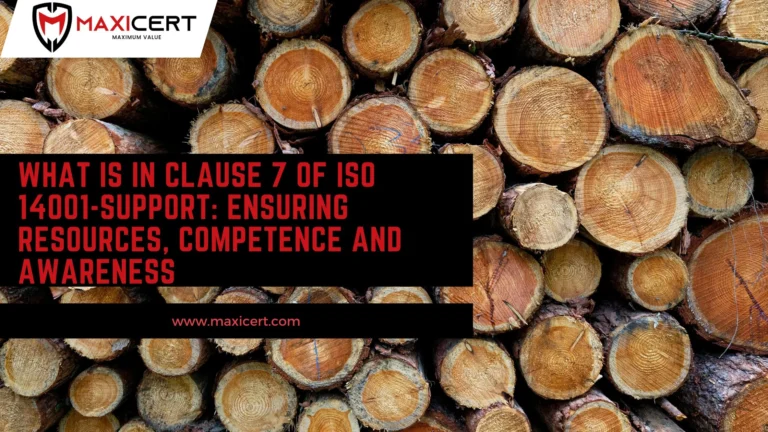What is in Clause 7 of ISO 14001-Support: Ensuring Resources, Competence and Awareness

Introduction
For an Environmental Management System (EMS) to be effective, an organization must ensure that adequate resources, competence, and awareness are in place. Clause 7 of ISO 14001:2015 emphasizes the provision of necessary support requirements to maintain and enhance environmental performance. This includes allocating financial, human, and technological resources, developing employee competencies, and fostering environmental awareness at all levels of the organization.
By implementing these ISO 14001 support mechanisms, organizations can enhance their ability to meet compliance obligations, achieve environmental objectives, and drive continual improvement in sustainability.
To implement Clause 7 effectively and meet your ISO 14001 certification goals, partner with Maxicert a leading provider of ISO certification services and one of the best ISO consultants for environmental management systems. Maxicert offers expert guidance, training, and compliance support tailored to your organization’s needs.
Request A Free Quote
Clause 7.1: Resources
Resources are needed for the effective functioning and improvement of the environmental management system and to enhance environmental performance. Top management should ensure that those with environmental management system responsibilities are supported with the necessary resources. An external provider may supplement internal resources.
An organization should determine the necessary resources for establishing, implementing. maintaining and improving the environmental management system. When determining the resources needed, the organization should consider:
- Infrastructure.
- Externally provided resources.
- Information systems.
- Competence.
- Technology.
- Financial, human and other resources specific to its activities, products and services.
Resources should be provided in a timely and efficient manner.
Resource allocations should consider the organization’s current and future needs. In allocating resources, the organization can track the benefits as well as the capital and operational costs of its environmental or related activities. Issues such as the cost of pollution control equipment (capital outlay) and the time spent by persons working under the organization’s control on making the environmental management system effective (operational outlay) can be included.
Resources and their allocation should be reviewed periodically, including in conjunction with the management review to ensure their adequacy. In evaluating adequacy of resources, consideration should be given to planned changes and / or new projects or operations.
Knowledge is an important resource for establishing or improving the environmental management system. When ad
Practical Help - Human, physical and financial resources
The resource base and organizational structure of smaller organizations can present certain limitations on environmental management system implementation. To overcome these limitations, the organization can consider cooperative strategies. Options can include cooperation with:
- Larger client and supplier organizations, to share technology and knowledge.
- Other organizations in a supply chain or local basis to define and address common issues, share experiences, facilitate technical development, use facilities jointly and collectively engage external resources.
- Standardization organizations, associations or chambers of commerce, for training and awareness programmes.
- Universities and other research centers, to support performance improvements, the application of life cycle perspective and innovation.
Clause 7.2: Competence
The competency requirements of ISO 14001:2015 apply to persons working under the organization’s control who affect its environmental performance, including persons:
Whose work has the potential to cause a significant environmental impact.
Who are assigned responsibilities for the environmental management system, including those who:
- Determine and evaluate environmental impacts or compliance obligations.
- Contribute to the achievement of an environmental objective.
- Respond to emergencies.
- Perform internal audits.
- Perform evaluations of compliance.
Knowledge, understanding, skills or abilities enable an individual to gain the necessary competence with regard to environmental performance. These persons include the organization’s own staff members, as well as those working under its control, such as external providers.
The competence requirements for these persons are not limited to those doing work that have or can have significant impacts on the environment but also those who manage a function or undertake a role, which is critical to achieving the intended outcomes of the environmental management system.
Many organizations do not have access to all these competencies and they often procure competent service providers to ensure environmental performance and the achievement of the intended outcomes of the environmental management system.
The organization should identify the necessary competencies required to fulfil the intended outcome of the environmental management system and address gaps. Documented information can be useful to ensure that identified competency needs are addressed, track progress on closing any gaps, and to enable communication of relevant information to interested parties.
Competence can be acquired through training. An organization’s training process(es) should include:
- Identification of training needs.
- Design and development of a training plan or programme to address defined training needs.
- Delivery of the training.
- Evaluation of the training result.
- Documentation and monitoring of training received.
An organization can evaluate the effectiveness of the training to confirm the intended result of the training is being achieved.
Competence
The organization shall:
- Determine the necessary competence of person(s) doing work under its control that affects its environmental performance and its ability to fulfill its compliance obligations.
- Ensure that these persons are competent on the basis of appropriate education, training or experience.
- Determine training needs associated with its environmental aspects and its environmental management system.
- Where applicable, take actions to acquire the necessary competence and evaluate the effectiveness of the actions taken.
Clause 7.3: Awareness
Awareness of the environmental policy should not be taken to mean that the commitments need to be memorized or that persons doing work under the organization’s control have a copy of the documented environmental policy. Rather, these persons should be aware of its existence, its purpose and their role in achieving the commitments, including how their work can affect the organization’s ability to fulfil its compliance obligations.
Top management has a key responsibility for building awareness in an organization in relation to the environmental management system and environmental performance, in order to enhance knowledge and promote behaviour that supports the organization’s environmental policy commitments. This includes making employees and other persons working under the organization’s control aware of the organization’s environmental values, and how these values can contribute towards organization’s business strategy.
Top management should ensure persons working under the organization’s control are encouraged to:
- Enhance environmental performance.
- Contribute toward achieving the intended outcomes of the environmental management system.
- Accept the importance of achieving the environmental objectives for which they are responsible or accountable.
Awareness
The organization shall ensure that persons doing work under the organization’s control are aware of:
- The environmental policy.
- The significant environmental aspects and related actual or potential environmental impacts associated with their work.
- Their contribution to the effectiveness of the environmental management system, including the benefits of enhanced environmental performance.
- The implications of not conforming with the environmental management system requirements, including not fulfilling the organization’s compliance obligations.
Top management should also ensure that all persons working under the organization’s control are made aware of:
- The organization’s environmental policy and its commitment to the environmental policy
- The importance of conforming to the requirements of the environmental management system.
- Their contribution to the effectiveness of the environmental management system.
- The benefits of improved environmental performance.
- Their responsibilities and accountabilities within the environmental management system.
- The significant actual or potential environmental aspects and associated impacts of their work activities.
- Identified risks and opportunities that need to be addressed in relation to their work activities, if applicable.
- The consequences of the departure from applicable environmental management system requirements, including the organization’s compliance obligations.
Examples of methods to increase awareness can include internal communication, visual signs and banners, campaigns, training or education, and mentoring.
Conclusion
Effective implementation of Clause 7 ensures that an EMS is well-supported with the right resources, skilled personnel, and informed employees. Organizations that invest in these areas are better positioned to improve sustainability, maintain compliance, and achieve their environmental goals.
Continuous learning and proactive resource allocation drive long-term success in environmental management.
To strengthen your ISO 14001 implementation and ensure full compliance with Clause 7 requirements, partner with Maxicert—a trusted global leader in ISO certification services. Maxicert provides expert consulting, training, and support to help you build a resilient, well-supported Environmental Management System.

Get In Touch

Get In Touch

Get In Touch
Need A Free Estimate?
Get a free consultation and Checklist to get certified for ISO , HALAL, CE Mark Certification.
FAQ
Is ISO 22000 certification mandatory in Oman?
Proper resource allocation ensures that an EMS functions efficiently, meeting compliance obligations while improving sustainability. It covers financial, human and technological resources needed for monitoring, compliance and environmental performance enhancement.
How can organizations develop employee competence in EMS?
Organizations can conduct training programs, competency assessments and on-the-job learning. They can also collaborate with external experts and industry associations to improve knowledge and skills.
What are effective ways to increase environmental awareness in employees?
Companies can use visual aids (signs, posters), training sessions, interactive workshops and internal communication campaigns to help employees understand their environmental responsibilities.



